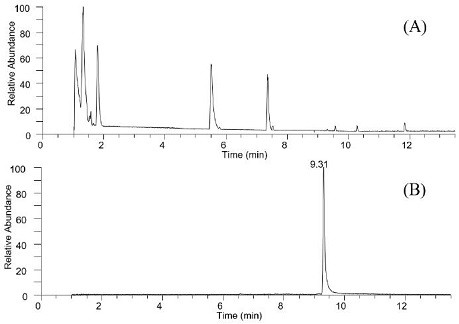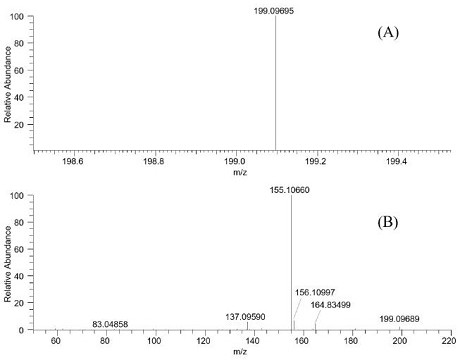2-decenedioic acid serving as indicative substance for honey authenticity evaluation and application of 2-decenedioic acid in honey adulteration identification
A decenedioic acid, authenticity technology, applied in the field of application in the identification of honey adulteration, can solve the problem of shortening the life cycle
- Summary
- Abstract
- Description
- Claims
- Application Information
AI Technical Summary
Problems solved by technology
Method used
Image
Examples
Embodiment 1
[0057] Example 1 Excavation and structure identification of endogenous substance 2-decenedioic acid in honey
[0058] In this embodiment, first, a large amount of honey and other common honeys are sampled and analyzed by the positive and negative modes of liquid chromatography tandem high-resolution mass spectrometry. The experimental results show that there is a compound with a higher content in the total ion chromatogram of honey in negative mode, such as figure 2 As shown, A is the total ion chromatogram of the honey sample, B is the precise extraction ion chromatogram of 2-decenedioic acid in the honey sample (mass extraction window is 5 ppm), and its chromatographic retention time is 9.38 min, The exact mass is m / z 199.09702.
[0059] Accurate mass based on high-resolution mass spectrometry m / z 199.09758 (R as image 3 Middle A figure), the present embodiment obtains the elemental composition of this material to be C 10 h 15 o 4 - . In the MS / MS spectrum of th...
Embodiment 2
[0061] Example 2 Contents of 2-decenedioic acid in different honey samples
[0062] 1. Sample source
[0063] Across the country, more than 500 common real honey samples were directly collected from beekeepers in different seasons and years to investigate the content of 2-decenedioic acid in various honeys. Species of bees are: acacia, jujube flower, rape, lychee, longan, vitex, eucalyptus, snow lotus, sunflower, tallow, pomegranate, wild osmanthus, wild dam, caragana, manuka, melon head, Goji berry, duck foot wood, Codonopsis pilosula, Galla, citrus honey samples, the number of single-flower honey samples of each variety is no less than 20.
[0064] 2. Solution preparation
[0065] Extraction solution: Pipette 20 mL of methanol, dilute to 100 mL with ultrapure water, and store at 4 °C.
[0066] 2-Decenedioic acid standard solution: Weigh 2 mg of decenedioic acid standard product, dilute to 2 mL with methanol, and store in a freezer at -20 ℃, with a validity period of 6 month...
Embodiment 3
[0081] Example 3 Application of 2-decenedioic acid as an indicator substance in the identification of honey adulteration
[0082] 1. Sample source
[0083] A total of 20 honey samples of various grades or brands labeled as honey were purchased from the market.
[0084] 2. Experimental steps
[0085] (1) Solution preparation
[0086] Extraction solution: pipette 20 mL of methanol, and dilute to 100 mL with ultrapure water. Store at 4°C.
[0087] 2-Decenedioic acid standard solution: Weigh 2 mg of decenedioic acid standard product, dilute to 2 mL with methanol, store at -20 ℃, valid for 6 months.
[0088] (2) Sample processing
[0089] Weigh 0.8 g of honey and add 7.2 mL of extraction solution, vortex at room temperature until completely dissolved, and in 20194 g , centrifuged at 4°C for 20 min. The supernatant was collected and passed through a 0.22 µm filter membrane, and then 100 µL of the extract: 900 µL of methanol and water was diluted once. The diluent was transfe...
PUM
 Login to View More
Login to View More Abstract
Description
Claims
Application Information
 Login to View More
Login to View More - R&D
- Intellectual Property
- Life Sciences
- Materials
- Tech Scout
- Unparalleled Data Quality
- Higher Quality Content
- 60% Fewer Hallucinations
Browse by: Latest US Patents, China's latest patents, Technical Efficacy Thesaurus, Application Domain, Technology Topic, Popular Technical Reports.
© 2025 PatSnap. All rights reserved.Legal|Privacy policy|Modern Slavery Act Transparency Statement|Sitemap|About US| Contact US: help@patsnap.com



